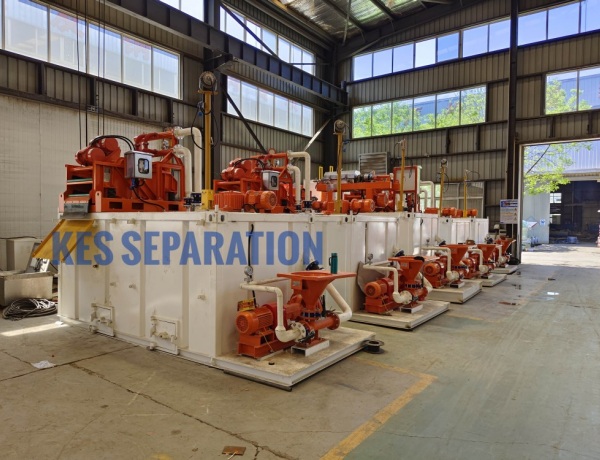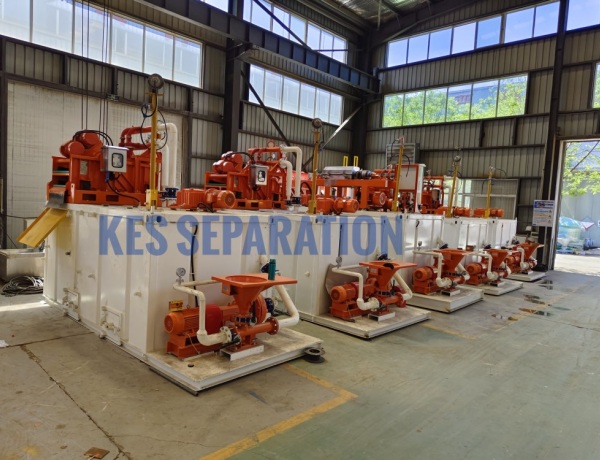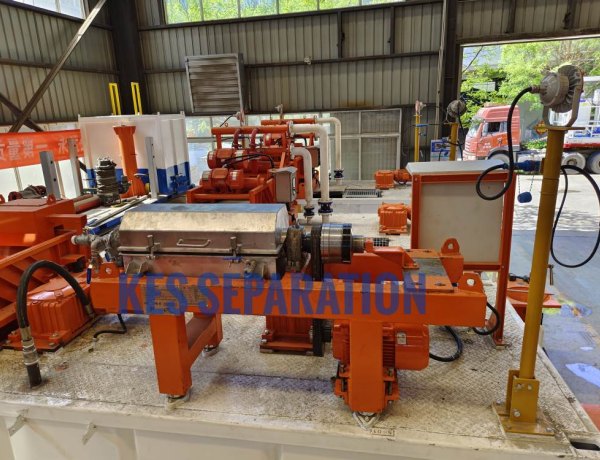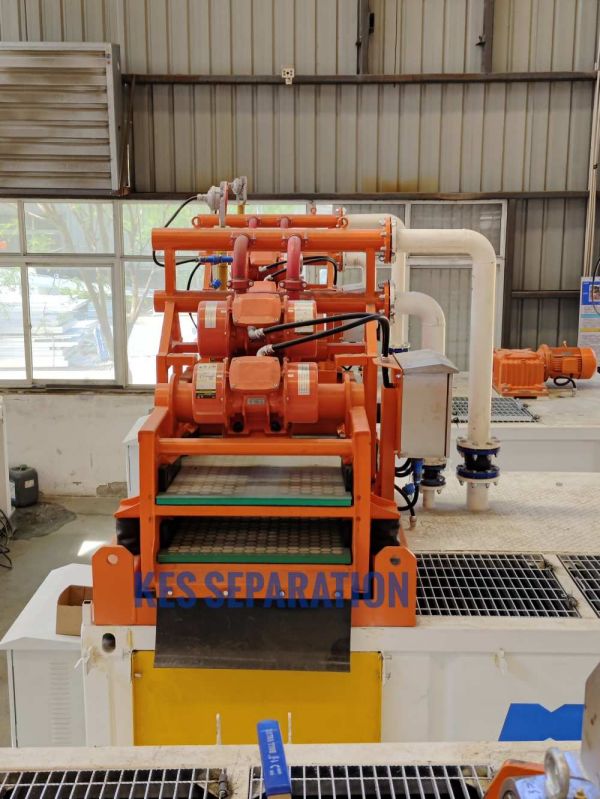

Mud desanding plants are typically used in the construction industry to treat the drilling mud that is used in various types of construction projects, such as pipe jacking, tunneling, foundation drilling, auger drilling and pile driving. The mud that is used in these types of construction activities typically contains a high level of sand and other abrasive particles, which can cause damage to drilling equipment and hinder the progress of the project.
Mud desanding plants are designed to remove these abrasive particles from the drilling mud, thereby reducing the wear and tear on drilling equipment and improving the overall efficiency of the construction project. The types of construction mud that need to be treated by a mud desanding plant include:
1. Bentonite-based
mud: This is a common type of drilling mud used in construction activities. It
is made by mixing bentonite clay with water to create a thick, viscous mud.
Bentonite-based mud can contain a significant amount of sand and other abrasive
particles, which can cause damage to drilling equipment if not properly
treated.
2. Polymer-based
mud: This type of mud is made by mixing synthetic polymers with water to create
a drilling fluid that is less prone to contamination and easier to handle.
However, polymer-based mud can still contain sand and other abrasive particles,
which can cause damage to drilling equipment and slow down the progress of the
construction project.
3. Water-based
mud: This is a type of drilling mud that is made by mixing water with various
additives, such as clays and polymers. Water-based mud can also contain sand
and other abrasive particles, which need to be removed by a mud desanding plant
before the mud can be reused in the construction project.
Overall, any type of drilling mud used in
construction activities that contains sand and other abrasive particles needs
to be treated by a mud desanding plant to ensure the efficiency and safety of
the project.

Our mud cleaning system can also be applied to core drilling, what is
core drilling?
Core drilling is a cutting process used to create circular holes in hard, thick materials such as concrete, stone, and asphalt. A core drill uses a hollow barrel-shaped cutting bit with diamond or carbide teeth that is rotated at high speeds to grind away the material and produce a cylindrical core sample. The core sample can be extracted and analyzed for different purposes, such as quality control testing, mineral exploration, or geological research. Core drilling is commonly used in construction, mining, and exploration industries, and requires specialized equipment and skilled operators.
Our mud cleaning system can also be applied to pipe jacking
construction, what is pipe jacking construction?
Pipe jacking construction is a trenchless
method of installing underground pipes, such as sewer, water, or gas pipelines,
without the need for excavating a large trench. It involves the use of a
hydraulic jacking system to push a steel or concrete pipe through the ground,
while simultaneously excavating the soil in front of it. This creates a tunnel
through which the pipe is installed,with the spoil removed continuously via a
conveyor system. The pipe is typically assembled in sections at a launch pit,
and as each section is pushed, new sections are added behind it, until the
entire pipeline is installed. Pipe jacking is a more environmentally-friendly
and cost-effective method of pipeline installation, as it causes minimal
disruption to the surrounding area, reduces traffic congestion, and allows for
faster installation times.

Our mud cleaning system can also be applied to TMB Tunnelling
construction, what is TMB Tunnelling?
TMB (tunneling method of construction under high water pressure) is a type of tunneling technique used for constructing tunnels under high water pressure. It is a variation of the shield tunneling method and is commonly used for constructing tunnels for subways, metro, and pipelines.
In TMB tunneling, a cylindrical tunneling shield is driven forward by hydraulic jacks, while the ground around it is excavated using a system of mechanical diggers and pumps. High-pressure water is used to balance the pressure inside the shield, and prevent water or soil from entering the tunnel face.
TMB tunneling requires specialized equipment and skilled operators to ensure safety and efficiency. It is a complex and expensive method of tunneling, but it is preferred in situations where other methods are not feasible, such as in underwater tunnels or in areas with unstable soil or high water pressure.
Our mud desanding plant can also be applied to foundation drilling,
what is foundation drilling ?
Foundation drilling is a process of creating deep, vertical holes in the ground to install concrete piles or other foundation elements for supporting structures such as buildings, bridges or towers. It is a type of geotechnical engineering technique that involves drilling through different types of soil, rocks, and boulders to create a stable foundation for a structure.
Foundation drilling is often used when constructing high-rise buildings, large bridges, or other structures that require a deep and strong foundation. The size and depth of the holes drilled depend on the design specifications, the type of soil, and the load capacity required for the structure to be supported.
Foundation drilling involves specialized
equipment such as drilling rigs, augers, and drill bits of different sizes and
shapes depending on the type and depth of soil or rock. The cuttings and debris
are usually removed to the surface using slurry or air pressure equipment.
After drilling, steel reinforcement cages are inserted into the holes, and
concrete is poured to create the foundation structure.

Our mud desanding plant can also be applied to HDD drilling, what is HDD drilling ?
HDD (horizontal directional drilling) is a trenchless method of drilling that is used to install underground pipelines, cables and conduits without the need for digging a large trench.
In HDD drilling, a drill rig is used to bore a pilot hole horizontally from the surface to the destination point underground, while the drilling fluid is sent to the surface to carry the cuttings away. Once the pilot hole is complete, a reaming tool is used to enlarge the hole to the desired size, typically with a diameter large enough to accommodate the pipeline or conduit.
The process of HDD drilling is highly controlled, with specialized sensors and monitoring equipment used to ensure that the pilot hole is drilled at the proper depth, angle and direction. It is commonly used in situations where traditional methods of underground installation are not feasible, such as under waterways, highways, railways, and other environmentally sensitive areas.
HDD drilling is an eco-friendly and cost-effective method of underground installation, as it results in less surface disruption, minimized environmental impact, and reduced construction time compared to traditional open-cut methods.
Our mud system can be applied to auger drilling. Usually, 4~6sets of auger drill can share one set mud system. What is auger drilling ?
Auger drilling is a drilling method that
uses a helical screw, called an auger, to create a hole in the ground. The
auger is rotated by a drill rig, and as it moves down, it collects soil or
other materials, which are then transported to the surface. Auger drilling is
commonly used for soil sampling, environmental drilling, geotechnical
investigation, and water well drilling.
One of the benefits of auger drilling is
that it is relatively fast and inexpensive compared to some other drilling
methods. It is also effective in drilling through relatively soft soil, such as
clay, sand, and loam. Auger drilling is particularly useful when drilling
shallow holes, often up to 50 feet deep or less, and where narrow boreholes are
needed such as for geothermal boreholes or wells for ground source heat pumps.
However, the downside of this method is that it is less effective in drilling
through hard materials like rock, and it creates less stable boreholes compared
to other drilling methods.

How to select suitable mud cleaning system for construction mud
treatment ?
To select a suitable mud cleaning system for construction mud treatment, you should consider several factors:
1. Type of mud or drilling fluid: The type of mud used in the construction site can affect the selection of the mud cleaning system. For instance, water-based mud may require a different cleaning system than oil-based mud.
2. Mud flow rate: Determine the mud flow rate that needs to be treated per hour. The higher the flow rate, the more powerful and efficient the mud cleaning system should be.
3. Particle size distribution: The particle size distribution of the drilling mud is an important factor to consider when selecting a mud cleaning system. If the mud contains fine particles, a system with a high capacity for removing fine solids is needed.
4. Solids removal efficiency: The efficiency of the mud cleaner to remove solids from the drilling mud is important to consider. A higher efficiency system can significantly reduce the amount of waste generated which affects the construction site's costs.
5. Footprint: The available space on the construction site can also influence the type of mud cleaning system selected. A smaller, more compact system could be appropriate for smaller construction sites.
6. Environmental regulations: Consideration of environmental regulations is crucial when selecting a mud cleaning system. Regulations require certain standards to be met to prevent environmental damage from polluted drilling mud runoff.
7. Cost: Finally, consider the cost of the mud cleaning system, which includes the purchase, installation, and maintenance costs of the system. The mud cleaning system chosen should be cost-effective, efficient and able to save you money in the long run.
By keeping these factors in mind, you will
be able to select a suitable mud cleaning system that meets the needs of your
construction site.